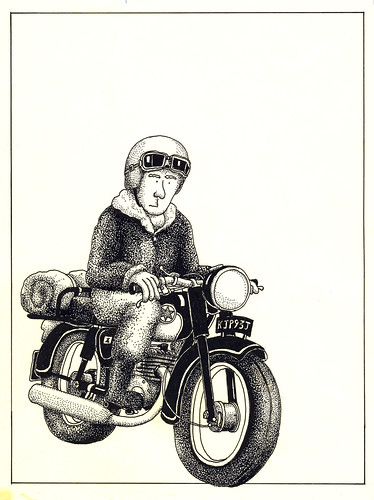 There is something hug-yourself-ish about coming across a felicitous sentence in an otherwise extremely matter-of-fact book. Like those occasional moments in Pevsner, when he allows himself a dry smile, as with Bristol's church of
There is something hug-yourself-ish about coming across a felicitous sentence in an otherwise extremely matter-of-fact book. Like those occasional moments in Pevsner, when he allows himself a dry smile, as with Bristol's church ofThe subject of workshop manuals came up yesterday, and I got to thinking of my old MZ motorbike manuals. The MZ (Motorradwerk Zschopau) was built in East Germany, and the paperwork was very 'socialist realism', printed on coarse paper and with very clunky black and white pictures.
St Paul, Portland Square (E). 1789-94 by Daniel Hague, perhaps with some help from or interference by the Vicar. One welcomes the tower in the skyline of Bristol, though Mr Whiffen is of course right in calling it 'rather monstrous'.

Germans do take their engineering seriously. Once, when I was working on a seismic survey ship, we were refitting in the Lindenau Werft in Kiel. The yard's engineers fitted a large water pump on the gun deck so that we could pump canisters of nitro-carbo-nitrate along a tube to explode them deep underwater. Several engineers in white helmets superintended the alignment of the pump and motor, then came in a delegation to where we sat drinking our tea and gasconading, and politely informed us that it was essential to maintain a clearance of 9 mm on the coupling.
We smiled and assured them that we would take every precaution.
They walked back to the pump and conferred earnestly. Then the delegation approached us again and presented me with a feeler gauge. "Nine millimeters!", they repeated. We exchanged smiles. It was a 'hands across the ocean' moment.
I felt honoured. The feeler gauge is in my toolbox still, though we never used it on the pump, and it worked fine anyway....

Now then, to the accidental lyricism of MZ manuals. I remember the performance data, stating top speed as 78 MPH with the caveat that 'rider should assume a sporting position (slightly stooped). No loose clothing!'
Sadly, I gave the books away long ago. But I found an online copy of the MZ workshop manual, and this is how it begins:
In the high latitudes of Finland, in the parching heat of Africa, hence, under the most different conditions, the MZ moto-cycles run to the satisfaction of their owners.
Heck, doesn't it make you pine for the open road?


Yes!!
ReplyDeleteOn a lime green TS250.
love
chrissiexxxx
Mine was black, with nice chrome panels on the tank. But my wish-list bike was the 'flying banana' ES250... definitely *differently* beautiful.
ReplyDeleteringdingdingding!
I remember my dad's Claas manuals for the combine harvester. There was 'Achtung!'on nearly every page. I don't know how he managed to keep the thing running, he didn't know any German (at first) and I don't remember any pictures.
ReplyDeleteHe would have loved your posts like this one.
I said Lime Green when I meant, of course, Alpine Green.
ReplyDeleteMind you, that colour was limited to the TS125 and 150, but my friend Rob loved it so much he got his TS250 sprayed in it.
I'd have also settled for a yellow one.
The later Saxon versions were spoiled, sadly. Re-engineered for style, they sacrificed all of the TS's accessibility. Mine was a nightmare to work on compared to my friend's 'seventies MZ's.
Oh, those lovely ringing chimes from the fins... And the smell of the pre-mix. The saxon had an oil pump; it just wasn't the same.
Incidently, do you know why the main bearings were so crap? I heard it was because they were made with little or no nickel content, as the Soviet Union used to requisition all the East German supplies of nickled bearings.
Love
chrissie
xxxx
ps, I think I have an old Bike magazine road test of a TS from back then. If you would like a photocopy let me know, Dru.
Seem to recall the MZ being more comfortable, speaking as a passenger. Or maybe it's just the only one I remember the make of. Apart from the Bantam in bits in the bedroom.
ReplyDeleteAchtungs can be quite alarming at first, if you previously encountered them in films or comics. No pictures? The manual for a MAN engine on a ship was thoroughly illustrated, and each task was headed by little stick men to show you how many operatives were needed for the task. There were white men for skilled workers, and black men for unskilled workers.
ReplyDeleteNo idea about the bearings, Chrissie. Eastern Bloc bearings were generally supposed to be unreliable, as I recall, and I had both main and output shaft bearings fail on me on my bike. Then again, the bottom bracket bearing cassette on my Claud Butler bicycle failed recently after a year. Meh. Thanks for the offer, but I would only start pining for another bike, and that would never do.
The MZ was definitely the most comfortable of the bikes, Mandy. There was the Laverda too, which we whizzed around Gwent on once and nearly fell off, if you remember. That's the Bantam in the picture up there, by the way.
Funnily enough, the name 'Laverda' popped into my head a couple of hours after I posted the comment.
ReplyDeleteSheep playing chicken, I remember it well.